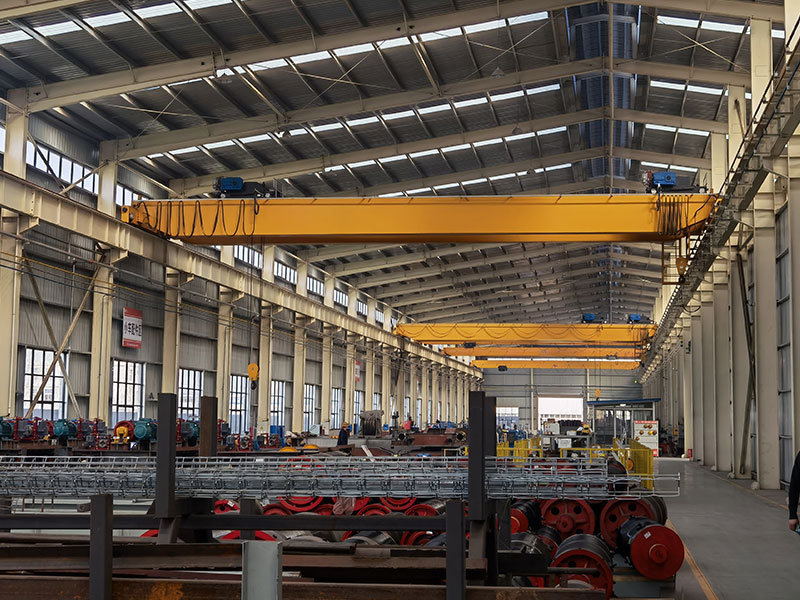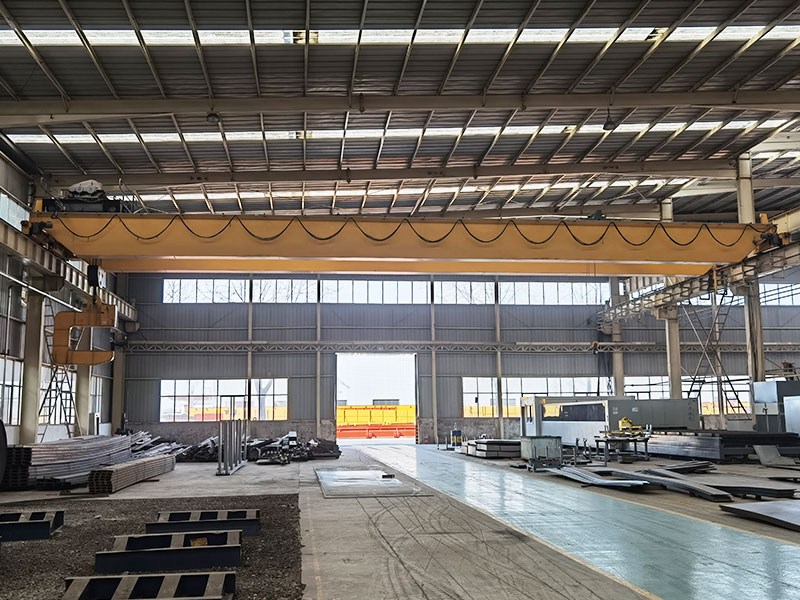Double girder bridge cranes are integral components in modern industrial environments, particularly in manufacturing, shipping, and construction. Their design and structure significantly contribute to their effectiveness in handling heavy loads and enhancing operational efficiency. This article explores the fundamental aspects of double girder bridge cranes, focusing on their design features, structural components, and advantages.

Overview of Double Girder Bridge Cranes
Double girder bridge cranes consist of two parallel girders, which form the main support structure of the crane. These girders run along the length of the runway and support the lifting mechanism, typically a hoist, which moves along the girder’s length. This configuration allows for greater lifting capacity and stability compared to single girder cranes, making them suitable for heavy-duty applications.
Design Features
- Girders: The Backbone of the Crane
The girders in a double girder eot crane are typically fabricated from high-strength steel, ensuring they can withstand significant loads. Their design is crucial for the overall stability and durability of the crane. The choice of material and the dimensions of the girders are determined based on the crane’s intended load capacity and span. Generally, the girders are designed to minimize deflection and stress concentration, which enhances the crane’s operational reliability.
- End Trucks
Each girder is equipped with end trucks, which are the moving components of the crane. These end trucks allow the crane to travel along the runway beams, which are installed parallel to the building’s structure. The end trucks consist of wheels that support the weight of the crane and are designed for smooth movement along the rails. The configuration of the end trucks also plays a vital role in maintaining the stability and alignment of the crane during operation.
- Hoisting Mechanism
The hoisting mechanism is mounted on top of the girders and can move horizontally across the span of the crane. This component typically includes a drum or chain hoist, which is responsible for lifting and lowering loads. The hoist’s motor is usually electric, providing a reliable power source for smooth operation. Depending on the design, the hoisting mechanism can also incorporate features like variable speed controls and overload protection systems to enhance safety and efficiency.
- Control Systems
Modern double girder bridge cranes are equipped with advanced control systems that allow operators to manage the crane’s movements precisely. These systems can be operated remotely or from a control cabin. Features such as programmable logic controllers (PLCs) enable operators to set specific lifting cycles, monitor load conditions, and ensure safe operation. Advanced control systems also incorporate safety measures, such as emergency stop buttons and load limiters.

Structural Components
- Runway Beams
The runway beams are the horizontal tracks along which the crane travels. They must be designed to accommodate the weight of the crane, including any loads being lifted. The design of the runway beams includes considerations for deflection, beam strength, and stability. Proper installation of the runway beams is critical, as any misalignment can lead to operational issues and safety hazards.
- Supports and Columns
The crane is supported by vertical columns, which connect the runway beams to the building structure or a dedicated support frame. These columns bear the weight of the crane and any loads it lifts. Their design must ensure sufficient strength to handle the vertical loads and lateral forces generated during crane operation. The spacing and configuration of the columns are determined by the crane’s dimensions and the specific application requirements.
- Safety Features
Safety is paramount in crane design. Double girder bridge cranes are equipped with various safety features, including:
- Limit Switches: These devices prevent the hoist from exceeding its maximum height or travel limits, reducing the risk of accidents.
- Overload Protection: Load limiters ensure that the crane does not exceed its rated load capacity, preventing structural failure.
- Emergency Stops: Emergency stop buttons are installed at strategic locations, allowing operators to halt operations immediately in case of an emergency.
- Anti-Collision Systems: In environments where multiple overhead cranes operate, anti-collision systems help prevent accidents by detecting the presence of other cranes or obstacles.
Advantages of Double Girder Bridge Cranes
- Higher Load Capacity
One of the primary advantages of double girder bridge cranes is their ability to lift heavier loads compared to single girder cranes. This is due to the increased structural support provided by the two girders, allowing for larger hoisting mechanisms and heavier lifting attachments.
- Larger Span and Headroom
Double girder cranes can be designed with longer spans between columns, providing more operational space underneath the crane. This feature is particularly beneficial in industrial settings where overhead space is limited. Additionally, the hoisting mechanism is typically positioned between the girders, allowing for higher lift heights and maximizing the usable vertical space.
- Increased Stability and Durability
The dual-girder design enhances the stability and durability of the Aicrane crane. The weight distribution across two girders reduces stress on individual components, minimizing wear and tear. This stability is crucial in environments with dynamic loads or frequent lifting cycles.
- Versatility in Applications
Double girder bridge cranes are suitable for various applications, including heavy manufacturing, shipping, and construction. Their design allows for customization, enabling operators to adapt the crane for specific tasks, such as handling oversized loads or integrating specialized attachments.
Conclusion
Understanding the design and structure of double girder bridge cranes is essential for anyone involved in their operation, maintenance, or procurement. These cranes are engineered for high performance, safety, and durability, making them indispensable in various industrial applications. By recognizing the key components and advantages of double girder bridge cranes, operators can make informed decisions about their usage, maintenance, and upgrades. Whether in manufacturing facilities, shipping yards, or construction sites, double girder bridge cranes play a critical role in optimizing material handling and enhancing overall productivity.